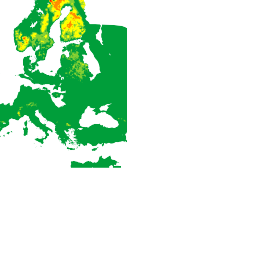Czym jest uniwersalny indeks pylenia (UPI)?
Uniwersalny indeks pylenia (UPI) to globalna skala, która umożliwia porównywanie poziomów pyłków w różnych obszarach. Indeks pomaga ocenić ryzyko narażenia na pyłki na podstawie różnych czynników w przypadku osób uczulonych lub wrażliwych na pyłki. Jest to reprezentacja danych o poziomie pyłków oparta na modelu wielowarstwowym, który uwzględnia stężenie w modelu rośliny, wiele różnych lokalnych wskaźników pyłkowych (LPI) używanych na całym świecie oraz alergenność różnych rodzajów pyłków roślin, aby przewidywać liczbę ziaren pyłku na metr sześcienny (ziaren/m³) dziennie.
Punkt końcowy heatmapTiles zwraca kafelki mapy termicznej, które można nakładać na mapę bazową. Kafelki mapy cieplnej wyświetlają UPI na całym świecie dla danego typu rośliny (TREE, GRASS lub WEED).
Indeks składa się z 6 kategorii:
| Wartość | Kolor | Opis |
|---|---|---|
| 0 | Brak | |
| 1 | Bardzo niska | |
| 2 | Niski | |
| 3 | Średnia | |
| 4 | Wysoki | |
| 5 | Bardzo wysoki |
Każda kategoria jest oparta na określonych poziomach stężenia pyłków w danym obszarze i ich wpływie na nasilenie objawów alergii, które zwykle występują, co zapewnia kompleksowe przedstawienie poziomów pyłków. Dzięki integracji z UPI użytkownicy mogą porównywać i oceniać warunki związane z pyłkami w różnych lokalizacjach.
Na przykład poniższy fragment mapy cieplnej pokazuje poziom pyłków w zakresie od bardzo niskiego do bardzo wysokiego:TREE

Obsługiwane rośliny
Interfejs Pollen API obsługuje 3 rodzaje roślin: trawy, chwasty i drzewa. Dostępność rośliny zależy od pomiarów i raportów z rzeczywistego źródła danych, dlatego dane o roślinach w interfejsie Pollen API mogą się różnić w zależności od lokalizacji.
Poniżej znajdziesz listę obsługiwanych kodów zakładów i ich metadanych:
| Kod zakładu | Wyświetlana nazwa | Typ |
|---|---|---|
ALDER |
Alder | Drzewo |
ASH |
Popielaty | Drzewo |
BIRCH |
Brzoza | Drzewo |
COTTONWOOD |
Cottonwood | Drzewo |
ELM |
Elm | Drzewo |
MAPLE |
Maple | Drzewo |
OLIVE |
Olive | Drzewo |
JUNIPER |
Juniper | Drzewo |
OAK |
Dąb | Drzewo |
PINE |
Pine | Drzewo |
CYPRESS_PINE |
Cyprysik | Drzewo |
HAZEL |
Zielonoszary | Drzewo |
GRAMINALES |
Trawy | trawa, |
JAPANESE_CEDAR |
Kryptomeria japońska | Drzewo |
JAPANESE_CYPRESS |
Cyprysik tępołuskowy | Drzewo |
RAGWEED |
Ambrozja | Chwasty |
MUGWORT |
Bylica | Chwasty |

